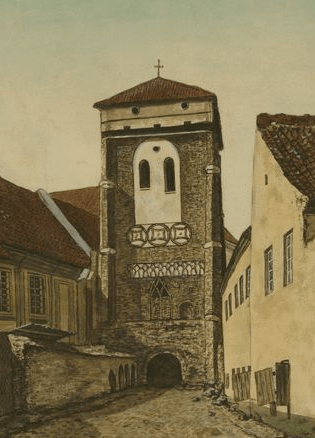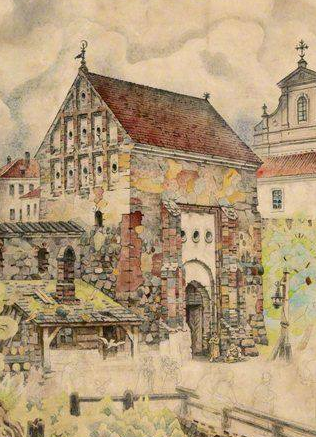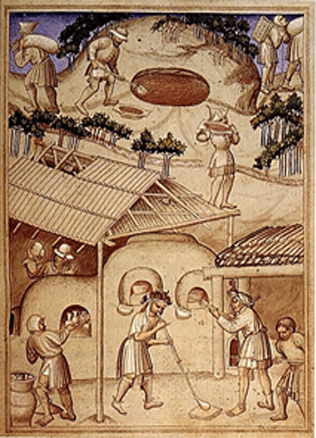Magnates of the GDL at the Meeting of the Jagiellonians and Habsburgs in Vienna in 1515
The meeting of the three European monarchs in Vienna in 1515, which was later called the First Congress of Vienna, was one of the most important events of the GDL’s Western diplomatic policy. It was perhaps the first time that a numerous delegation of the Lithuanian political elite participated in such a high-level meeting, as the members of the delegation created direct ties with the Habsburgs, the ruling dynasty of the Holy Roman Empire. Starting from the first half of the 16th century, officials who were sent from Vilnius with various diplomatic missions began visiting the emperor’s manor estate in Vienna. Thus the international representation of Lithuania in Vienna in 1515 was a success.
Military conflict ending with two engagements
Do You Know?
Peace was made at the First Congress of Vienna in 1515 between the Habsburgs and the Jagiellonians, who had entrenched themselves in Central and Eastern Europe. They crowned this peace with a double wedding. Louis, who was the son of Vladislaus and thus the successor of the throne of Hungary and Bohemia, was to marry Maximilian’s granddaughter Mary of Austria, while Louis’ sister Anna was to marry Mary’s brother Ferdinand. This event was immortalized in a woodcut by Albrecht Dürer. In the right-hand corner near Sigismund the Old, a leaning shield is depicted with the symbols of Poland and the GDL.
The pre-history of the congress was not favourable for the GDL and Poland. The Habsburg dynasty of the beginning of the 16th century, which had not given up their claims to the thrones of Hungary and Bohemia, created a broad coalition against the Jagiellonians, who had entrenched themselves in Central and Eastern Europe. The Grand Duchy of Moscow was invited to the coalition, which was waging war with Lithuania at the time, as was Prussia, because Albrecht, the Grand Master of the Teutonic Order had refused to recognise Prussia as a vassal of Poland. There were plans to include Denmark, Brandenburg, Saxony and Moldova in the coalition. There was a threat of the Jagiellonians being surrounded by hostile states. This situation was changed by the joint Lithuanian and Polish military victory against Moscow: the soldiers led by the Grand Hetman of the GDL Konstanty Iwanowicz Ostrogski defeated the Muscovites in the Battle of Orsha on September 8th, 1514. The Habsburgs changed their tactics and looked for common talking points. The hostilities were to be mitigated by the meeting of the monarchs of the Holy Roman Empire, Poland and the GDL along with those of Hungary and Bohemia in the summer of 1515.
The preliminary negotiations of rulers Maximilian Habsburg and brothers Vladislaus Jagiellon and Sigismund the Old took place in Bratislava in May 1515. The final agreements were signed in Vienna. On July 17th, the three monarchs, accompanied by an entourage, arrived in festive fashion to Vienna. The rulers’ entrance and main event (July 20th-22nd) was described in detail by humanist Johannes Cuspinian, who was a diplomat of Maximilian’s as well as a doctor and historian. In his diary, Praefecti urbis Viennensis, he wrote the “Diarium de congressu Caes[aris] Maximiliani Aug[usti] et trium regum, Vladislai Hungariae, Ludouici Bohemiae, et Sigismundi Poloniae, in urbe Viennensi facto, XVI. Julii, Anno Christi M. D. XV.” (Rerum Germanicarum Scriptores, 1717, t. 2, f. 587–612).
With the cooperation agreements signed at the First Congress of Vienna, political influence and territories in Central and Eastern Europe were divided up among them. One of the most important successes for Lithuania was the termination of the union between the Habsburgs and the Grand Duchy of Moscow. Maximilian was obliged to not support the Teutonic Order, which is why he was guaranteed the right to inherit the thrones of Hungary and Bohemia, if the Jagiellonian dynasty would not inherit these thrones. All of this was cemented with two dynastic engagements. Vladislaus’ son Louis the Jagiellonian (the heir to the throne of Hungary and Bohemia) was to marry Maximilian’s granddaughter Mary of Austria, while Louis’ sister Anna was to marry Mary’s brother Ferdinand. This event was immortalized by Albrecht Dürer. In the right corner of the woodcut near Sigismund the Old, a leaning shield is depicted that has the symbols of Poland and the GDL.
The “barbarian” Lithuanians stun Europe
Information about the Lithuanian delegation that accompanied Sigismund the Old and what they did is scant. Johannes Cuspinian did not write anything about it, while a bit more information was provided in Maciej Stryjkowski’s Chronicle of Poland, Lithuania, Samogitia and all of Ruthenia, and later in Short Story by Solomon Rysiński, a courtier of the Radziwiłł. Two influential GDL nobles that were part of the entourage together with their own people were Vilnius Voivode Mikołaj Radziwiłł (1470–1521) and, according to Strykowski, Stanislovas Goštautas (born between 1507 and 1510). However, this latter noble could not have been in Vienna, as he was too young. Most likely it was his father, Polotsk Voivode Albertas Goštautas, who had gone to the congress.
Up until that point, Lithuanians were an unknown nation of barbarians from a backward land for the Germans and Italians that were in Maximilian’s entourage, as well as for the inhabitants of Vienna.
In attempting to disprove this image and match the culture of the foreign nobility, the wealthy representatives of Lithuania strived to amaze everyone with their ornate garments and musicians. Historians have repeated the message numerous times that the aforementioned nobles of Lithuania made a huge impression on the Westerners, bringing 100 musicians to Vienna who played for the emperor during prayers. According to Stryjkowski, Radziwiłł and Goštautas “at great expense brought more than one hundred musicians from Poland. They were young people dressed up as Muscovites, Tatars and Cossacks, who played various musical instruments, were decked out with swords and scabbards and wore pointed shoes in the church, sang Holy Mass and evening prayers, wanting to perform for the emperor, greatly impressing the people nearby, the Germans and Italians, who earlier had imagined the Lithuanians as being churls.”
Moreover, on the basis of information Rysiński had, during this high-level meeting, “Radziwiłł was the only one in this summit of various nations and various nobles that was chosen together with the Spanish envoy to accompany the Hungarian Princess Anna, the sister of King Louis, to the church with Emperor Maximilian to celebrate the engagement.”
Lasting ties were forged
The leaders of the Lithuanian delegation in Vienna established ties not only with European nobility, but with the ruling Habsburg dynasty. The Goštautas and Radziwiłł clans expanded these ties also later. For example, Mikołaj Radziwiłł respectfully received and gave gifts to Maximilian’s envoy Sigismund Herberstein as he was travelling through Lithuania. According to his envoy, already earlier he had given a letter from the emperor to the noble and for that received several wonderful horses, “now once again he brought me a wonderful castrated horse as a gift. Radziwiłł also gave me a few Hungarian gold pieces, exhorting me to have a ring made from them; taking it off and looking at it every day, I would be able to remember him easier, especially when I will be with the emperor.” Goštautas acted in a similar manner. Thus, it is no surprise that both nobles were among the first GDL nobles that received the titles of duke and count from the Holy Roman emperor. The path tread by these nobles at the Vienna court was soon visited by later GDL elite, including Mikołaj Radziwiłł the Black (1547), and diplomat Wawrzyniec Międzyleski, who was sent from Vilnius, along with many others.
Thus the First Congress of Vienna in 1515 was valuable for the GDL first of all because of the political agreements that broke up the anti-Lithuanian and anti-Polish coalition. The delegation from Lithuania forged contacts with the Habsburg dynasty, which was at the time part of the elite of the Holy Roman Empire.
Literature: K. Baczkowski, Zjazd wiedeński 1515. Geneza, przebieg i znaczenie, Warszawa, 1975.
Raimonda Ragauskienė



